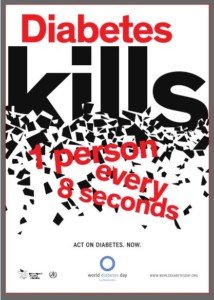
If diabetes can be controlled, why do so many Americans die from it every year?
According to the National Diabetes Statistics Report, 2014, diabetes was the seventh leading cause of death in the U.S in 2010 (over 69,000 deaths).
In that year there were over 234,000 death certificates listing diabetes as a contributing or underlying cause of death.
Diabetes is also a leading cause of blindness and amputations in U.S. adults.
This disease, as you can see, is very destructive. However, diabetes can be controlled. Have you ever heard someone say, “I have type 2 diabetes, but I control it with diet and exercise?”
Since type 2 diabetes can be controlled with diet and exercise, why do so many people die from it and even more develop serious complications leading to disability?
As for type 1, this, too, can be controlled, but requires daily injections of insulin.
Difference Between Type 1 and Type 2
In type 1 (10 percent of all cases), the pancreas fails to produce insulin—a hormone that shuttles blood sugar to muscle cells. The result is too much sugar in the blood.
In type 2, the pancreas works fine. The problem is with the insulin receptor sites on muscle cells:
They don’t work efficiently, and/or there’s not enough of them. The result is too much sugar in the blood.
Controlling Diabetes
Insulin injections provide insulin so that the blood sugar can be taken to the insulin receptor sites.
Exercise lowers blood sugar by forcing the muscles to demand more sugar.
Those with type 1 can exercise all they want, but without insulin, there’s nothing to shuttle the blood sugar to their muscle cells.
Diet is important: Too many refined carbohydrates, especially all at once, overload the blood with sugar.

“Although it can be controlled, it does not mean that most people do a good job,” says John Whyte, MD, board certified internist in Washington, DC, and author of “Is This Normal? The Essential Guide to Middle Age and Beyond.”
This is easy to believe. I used to work at a place where there were two diabetics.
One pedaled hard every day on a stationary bike, kept his weight in check and watched what he ate.
The other was overweight and was frequently seen eating junk food.
Dr. Whyte explains, “Diabetes is a progressive disease — which means that beta-cells in the pancreas which are responsible for insulin continue to ‘burn out.’ Changing our diet and taking medicines can slow that down, but all too often patients either don’t take their medicine as directed, or they don’t make changes to their lifestyle.
“It can be hard to make the healthy choice if you’ve grown up with processed foods and a love of candy!
“And if you have always been a couch potato, one doesn’t change overnight.
“I always get frustrated when patients are very reluctant to start insulin, and then after a few months, their diet gets worse since they learned [incorrectly] if they eat a cupcake, they can just take more insulin.
“So the reality is that we see far fewer complications when patients have good control. But we’re not doing a good enough job helping patients understand the importance of daily control.”
Controlling diabetes also means regularly checking blood sugar levels. Many people neglect to do this when they should.



























